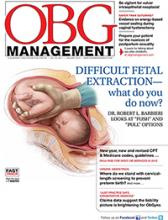“DIFFICULT FETAL EXTRACTION AT CESAREAN DELIVERY: WHAT SHOULD YOU DO?”
ROBERT L. BARBIERI, MD (EDITORIAL; JANUARY 2012)
The OBG Management mailbox overflowed after publication of Dr. Robert L. Barbieri’s January 2012 Editorial on difficult fetal extraction at cesarean delivery—and the letters we received offered a host of refinements to, and variations on, the push or reverse breech maneuvers he described. Here are some of the suggestions and solutions received from readers.
How I prevailed over a case of difficult fetal extraction
At 4 am on February 6, I was on call at the hospital when the family medicine resident contacted me about a patient with preterm premature rupture of membranes who had gone into labor. The patient was at 32 weeks, 4 days gestation. The resident had performed a pelvic exam and felt a fetal hand!
I rushed over to check the patient and found her cervix completely dilated, with the fetus in the vertex position and a fetal hand on one side. I tried as hard as I could to push the hand back in, without success.
We rushed the patient to the operating room for a stat cesarean delivery. However, I simply could not get my hand deep enough into the pelvis to deliver the head. I had the nurse push the fetal head from below, but I still could not reach it after several attempts. This had never happened to me in 34 years of ObGyn practice!
Out of desperation, I instinctively made a “T” incision on the uterus, reached inside, and grabbed the baby’s feet. Then, flexing the baby, I brought the feet down and delivered the baby as a breech. The infant’s hand and head were jammed into the pelvis. The hand was swollen, and the wrist was bruised. I had never heard of this maneuver before and had never considered doing it.
When I related the incident to my colleagues, one of my partners mentioned that he had just read Dr. Barbieri’s article, in which he described the very technique I had used! I was glad to know that there are other OBs who are using this approach—and that it isn’t unthinkable!
Many years ago, I had a similar experience, in that the nurse could not move the fetal head from below. I placed my right hand under the drape, into the vagina, and pushed the fetal head up while my left hand pulled the baby’s shoulders out of the pelvis. Sometimes it pays to double-glove when you anticipate difficulty getting the fetal head out of the pelvis. This maneuver—with both parts performed by the surgeon—has an advantage: You know how hard to push and pull because the operator is the same person.
Thanks to Dr. Barbieri for an excellent, timely article!
Caleb Liem, MD
Salinas, Calif
The many uses of nitroglycerine
The magic bullet in many cases of difficult fetal extraction is sublingual nitroglycerine spray. Most cases of impaction at cesarean delivery are caused by sustained uterine contraction or increased uterine tone. These situations can become easy deliveries in almost all cases when nitroglycerine is given. In our institution, all anesthetists carry nitroglycerine in the anesthesia cart, ready to go.
This approach is also useful when breech extraction of a second twin becomes difficult, and in cases involving podalic version of a second twin. It also is helpful in some cases of shoulder dystocia. In fact, this drug and its OB applications would be worth an entire article!
A common problem is not giving sufficient nitroglycerine quickly enough because of concern about maternal hypotension. I recommend giving 400 μg of sublingual spray every 30 to 60 seconds until the uterus relaxes or systolic blood pressure drops below 90 mm Hg.
Mark Jacobs, MD
Mill Valley, Calif
“Crawling” the forefingers along the fetal skull
The vaginal hand technique described in Dr. Barbieri’s editorial was used frequently in the program in which I trained. In performing this technique, I have noticed that I often “crawl” my fingers into place below the fetal head by alternately flexing and extending my forefingers along the skull.
I began using a similar technique of elevating the fetus abdominally prior to the hysterotomy. I feel along the lower uterine segment, putting pressure on the uterus, to palpate the fetal skull. I then gently wedge my forefingers into the space between the pubic symphysis and the bladder reflection by “crawling” my forefingers to elevate the head slightly. If I cannot palpate the fetal head, I try to elevate the fetal shoulder in a similar fashion. I then place the bladder blade into position, which either elevates the fetus within the uterus or elevates the uterus within the pelvis. In either case, it makes delivery of the fetal head after hysterotomy much easier.
Be careful not to injure the bladder while crawling the fingers into position. (I have never experienced a bladder injury using this method.)
Michael Nix, MD
Austin, Tex



